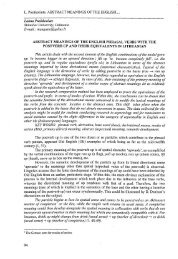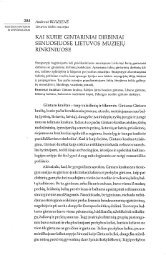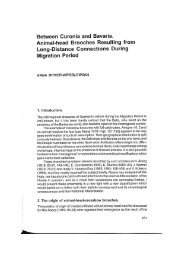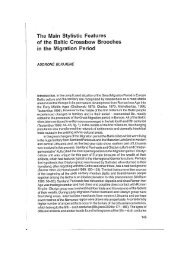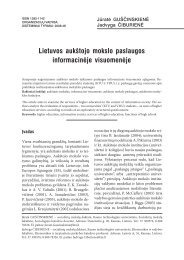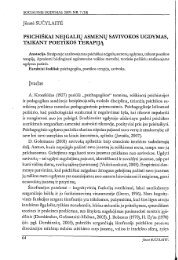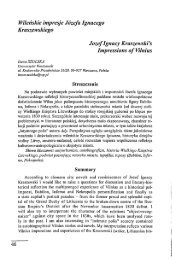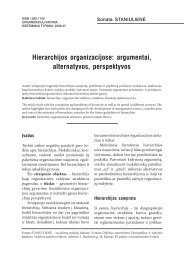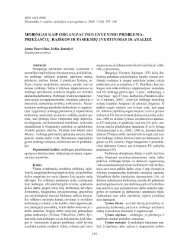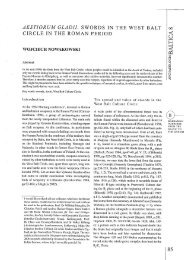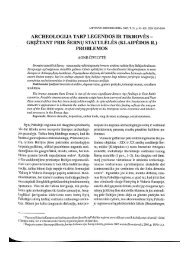ECO-MARKETING AND ECO-LABELLING: DOES IT ENSURE ...
ECO-MARKETING AND ECO-LABELLING: DOES IT ENSURE ...
ECO-MARKETING AND ECO-LABELLING: DOES IT ENSURE ...
You also want an ePaper? Increase the reach of your titles
YUMPU automatically turns print PDFs into web optimized ePapers that Google loves.
D.Grundey 166 ISSN 1648-4460<br />
Researching Customer Loyalty in Lithuania<br />
established in nearly all EU and EFTA countries (Rubik and Scholl, 2002) (Figure 2).<br />
4500<br />
40(Ю<br />
3500<br />
Э0(Ю<br />
2500<br />
20OT<br />
tsoo<br />
1000<br />
500<br />
0<br />
Hurnber of Products fabelled<br />
with the "Blue Angel"<br />
Status: September 1999<br />
ra<br />
Ntffnber oT new Products<br />
n thie course of a year<br />
Expired contracts at the erxf of a year<br />
due to further dovelopmerit of criteria<br />
Updated number of labelled<br />
products on 31.12. of a year<br />
1¿. Ш<br />
1991 1992 1393 1994 1 995 1996 1997 1993 1999*<br />
Source: RAL, Unweltbundesamt; Status: September 1999 • status of 03.09 1999<br />
Figure 2. Number of products labelled with the "Blue Angel" in Germany, 1991-1999<br />
Most of the labels are nationally based and are run by national eco<br />
labelling bodies, with the exception of the White Swan^ established by the<br />
Nordic Council of Ministers and valid for all the Nordic countries (Norway,<br />
Sweden, Denmark, Finland and Iceland). The labels cover both consumables,<br />
durables and services, and the main focus is the environmental impact of the product, in a life<br />
cycle perspective. In most cases the classical eco-labels do not include foodstuffs. There are<br />
usually developed separate national labels for organic food. The criteria are developed in a<br />
multi-stakeholder perspective and the actual label is a positive, well-known symbol.<br />
The EU-flower'' covers goods and services within the European<br />
:'^'\ Economical Area and was established by EU directive in 1992. The EU-flower<br />
has so far not managed to function as an effective environmental product<br />
information scheme in Europe.<br />
for awarding the Blue Angel includes: the efficient use of fossil fuels, alternative products with less of an impact on the<br />
climate, reduction of greenhouse gas emission, and conservation of resources. Once approved, eco-labelcd products are<br />
reviewed every two or three years to reflect slale-of-the-art developments in ecological technology and product design.<br />
Germany's Blue Angel certification for computers is primarily concerned with waste avoidance and reuse potential.<br />
According to the web site, "Pursuance of these aims helps to prevent possible entries of pollutants into the environment,<br />
protect resources and save disposal site space." As a result, their Environmental Label is "awarded to those products which<br />
combine a potential longevity of the system and its components with a recyclable design and the opportunity to reuse and<br />
recycle used products or product components. In addition, the use of environmentally harmful substances shall be avoided<br />
wherever possible." The Basic Criteria apply to components of workstation computers, including workstations consisting of<br />
controller (console), keyboard and monitor. Most products that qualify appear to be of strictly European make and/or model.<br />
' In November 1989, the Nordic Council of Ministers adopted a measure to implement a voluntary, positive co-labeling<br />
scheme in the Nordic countries (Norway, Sweden, Finland, Iceland, and Denmark). The objective of this ecodabcling was to<br />
provide information to consumers to enable them to select products that are the least harmful to the environment. Nordic Colabeling<br />
follows the ISO 14024 standard: "Environmental labels and declarations - Guiding principles". The criteria for colabeling<br />
include requirements for the composition of the product, constmction, materials, chemicals, marking of parts, waste<br />
disposal, recycling, energy consumption, noise level, ergonomics, electromagnetic fields and safety of use. The criteria base<br />
been fixed taking into account the environmental load during the whole life cycle of the product and the principles of the<br />
scheme for recyclable products (DFR - Design for Recycling).<br />
* The EU eco-labeling program was launched throughout the European Community in 1993 to encourage the manufacture of<br />
less environmentally damaging products. The European Union's Eco-labcl, a flower with the EU's star symbol, is awarded to<br />
products that have passed a life cycle analysis. On 26 February 1999 the Commission adopted the criteria for Personal<br />
Computers. These criteria are valid as of 1 March 1999 until March 2002 and producers can apply for llic eco-labcl. The<br />
product group definition is a commercially available stationary computers consisting ofa monitor, system unit, and keyboard.<br />
The criteria focus on: a) energy consumption, b) life-time extension, c) take-back and recycling, d) user instructions.<br />
RW^XKSVOIMATIONSLNMSLNVSS C~V.C0K0MICS, VOI. 8, No 1 (16), 2009



